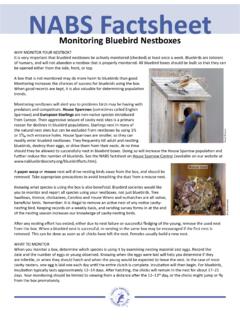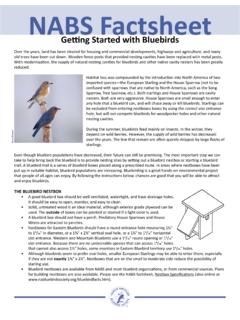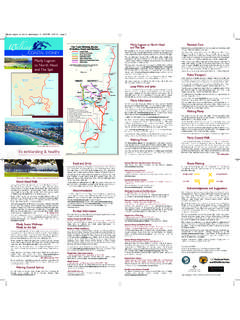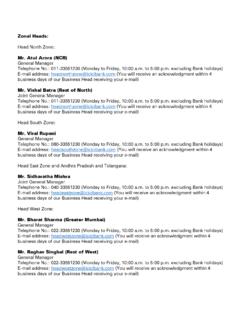Transcription of NAS ateet - North American Bluebird Society
1 NABS Factsheet Predator Control Putting up a nestbox is a responsibility that should not be taken lightly. When you put up a box, a commitment is made to provide as safe a place as possible for bluebirds to raise their young. If this commitment is taken seriously, both you and the bluebirds will be rewarded. Bluebirding is a great outdoor activity but, from time to time, problems will arise on your trail. Common problems include weather, attacks by House Sparrows, House Wrens, and climbing predators such as raccoons, cats, and snakes. We cannot control the weather. House Sparrows and House Wrens are a challenge. But losses due to climbing predators can and should be controlled by using proper baffles and good trail management practices. Jim Williams Proper box placement can be a factor in reducing raccoon predation.
2 Boxes placed in pastures or grasslands are less likely to attract raccoons, compared to boxes placed near wooded areas with ponds or streams nearby ( , riparian corridors). There are two definite lines of defense against raccoons. The best approach is to keep the raccoon getting onto the box. The second is to prevent the raccoon from reaching into the box if it gets in a position to try. This factsheet summarizes some methods used by experienced bluebirders. Note that similar preventive methods apply to snakes and cats. Snakes can climb smooth poles, even greased ones. Snakes are more of a common problem in the southeastern states ( , rat snakes) and in some western states ( , gopher snake) but snake problems may occur across most of North America. The stovepipe, PVC pipe, and cone guards shown below are effective for snake control; the larger the diameter of the guard, the better its effectiveness.
3 A 24-inch piece of hardware cloth placed directly underneath the box also helps. A Noel guard attached to the entrance of a nestbox can reduce the reach of predators trying to remove nestbox contents. Both domestic and feral cats pose a threat to bluebirds. The guards mentioned below may deter a cat, but some can jump as high as 6 feet. If cats are in your area, place your box as high as possible on a smooth pole. Using boxes with large, overhanging roofs can also add to the difficulty of predator trying to accessing the nestbox. Do not let the possibility of predation problems discourage you from putting up a Bluebird box. Mounting your box on a smooth round pipe will greatly reduce the chance of a loss to a predator. Other preventative measures (like described below) will provide additional protection.
4 WIkimedia/raccoon: Bernard Landgraf / black rat snake: Carly Lesser /. cat: Jennifer Barnard MOUNTING SYSTEMS. The easiest way to mount a Bluebird box would be to nail it to a wooden fence post or to a tree. This approach may work in certain parts of North America ( , prairies) where populations of raccoons or snakes are low, but it is generally not recommended in the Eastern parts of the continent. Mice, chipmunks, and squirrels in those areas may also raid nestboxes on trees. Raccoons climb trees and walk fence lines where they may eventually find your box. Taking the time to mount your boxes in the proper location will minimize your raccoon problems. A smooth clean pipe is the best mounting system to use. A 10-foot piece of -inch to 1-inch electrical conduit pipe can be purchased for a modest price.
5 It can then be cut down to a length of approximately 8 feet. Driving 2 feet of pipe in the ground leaves a solid six foot stand of pipe above. Electrical conduit is zinc-plated and will keep its slick surface ". for many years. Other kinds of heavy round pipe will also work well. Scrap pipe found at construction sites and salvage yards can also be used. An excellent source of pipe is from overhead garage door companies. In their scrap piles from discarded doors, you will find either an 8 foot or 16 foot pieces of 1 inch pipe. Most businesses will be glad to give them to you. If the pipe is rusty, sand it smooth. Flattening the bottom of the pipe with a heavy hammer will help stabilize the pipe and keep it from turning. For putting the pipe in the ground, a fencepost driver or 35 lb.
6 Digging bar is often better than a heavy hammer. Here are some other easy ways to mount a nestbox to the pole: Pre-drill two 5/16-inch holes through both the conduit or pipe and the back of the box. Use 1/4-inch bolts to anchor the box to the pole. The drilling can be done before placement in the field. Wrap two pieces of pipe strap around the pole and screw it into the back of the box on either side of the pole. Secure another small piece of pipe strap to the back top, and bend it down into the pole to keep the box from turning. Place two electrical conduit hangers around the pole and screw them into the box. Drill one hole at the top of the nestbox and pole. Use a U-clamp at the bottom of the box to secure it to the pole and keep it from swinging. A method that works well for mounting lightweight boxes (like Gilbertson PVC boxes) is to use a 5-foot piece of -inch electrical conduit slipped over a 5-foot piece of rebar driven approximately 2 feet into the ground.
7 A conduit connector (with a longer (5/8 ) bottom screw) at the base will keep the conduit from turning on the rebar. A nestbox may also be mounted on PVC pipe. Slip a 4-inch PVC pipe over a metal T-post, which makes a secure system when your box is located in a pasture with cattle. Mount your box high enough on the PVC so that cattle will not have any sharp corners to rub against. Downspout can also be used. A 10-foot length of downspout can be cut into three pieces (3-foot 4-inchs each), which is attached to the back of the box. This can then be slipped over a metal T-post. If possible, don't install your boxes within 10 feet of a tree or any other secure object from which a predator or other pest (raccoon, cat, squirrel, etc.) can jump on to the box.
8 A recent scientific study by the Cornell Laboratory of Ornithology using Nest Watch data from bluebirders has shown that using a proper nestbox along with a predator guard , as described in the next section, is a proven deterrent to climbing predators. For added protection, polish the pole down with steel wool and /or apply a layer of Carnauba car wax or silicone spray. POLE GUARDS. In areas with climbing predators a guard or baffle on the nestbox mounting pole should be used. Larger diameter guards are better than smaller diameter ones. Guard designs that have proved to be successful include the Kingston Stove Pipe guard, the Zeleny Cone, and the 4 6 inch PVC pipe baffle: Kingston Stove Pipe Guard This guard, designed by Ron Kingston, deters snakes, raccoons, opossums, and cats.
9 Material List: Galvanized stove or vent pipe, 8-inch diameter x 24 inches long 1/2-inch hardware cloth (flexible wire mesh). 2 hanger iron straps, 7 inches long 2 No. 8 B32 x 3/4-inch machine screws and nuts Instructions: 1. Use tin snips (offset are best) to cut a hardware cloth circle that is 2" wider than the stovepipe. Be careful of cuts and scrapes. (wear hand protection , leather gloves for these operations). 2. Cut a small hole or X in the middle of the circle (the diameter of your pipe - usually 1/2 to 1 inch.). 3. Put the circle over the top of the stovepipe. Then bend the edges down one inch all around so it that it fits tightly INSIDE the stovepipe. 4. Cut three tabs in the top of the stovepipe. Bend these over the hardware cloth. 5. Bolt the two strips of hanger iron (or a hose clamp) securely on either side of the mounting pipe, and bend them to support the hardware cloth.
10 Duct tape wrapped around the pole helps hold the hanger iron in place. Alternatively, drill a hole through the pipe, push a threaded rod or screw through it, and hang the guard on it. 6. Double-check that there are no gaps that would allow snakes to squeeze through. You can take a slotted screwdriver and use it to pry the hardware cloth up snuggly against the stovepipe sides. 7. Slip the assembled baffle over the pole until it rests on the hanger iron bracket. The top of the baffle needs to be at least four feet off the ground. The baffle should wobble freely to further discourage climbing predators. Zeleny Cone Baffel Note that the edges of the cone may be quite sharp, posing a hazard to children and interfering with monitoring. Material List: 3-foot diameter circle of 24- or 26-gauge galvanized sheet metal 1/4-inch round head stove bolts 2 hanger iron straps Disc blades also work well and can easily be found at farm auctions.












